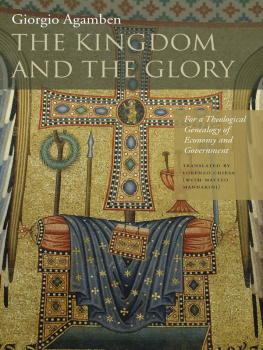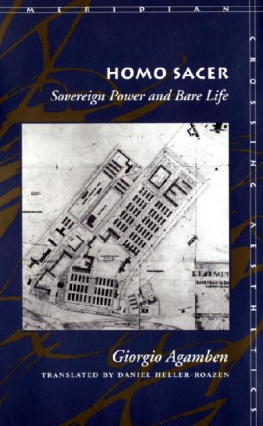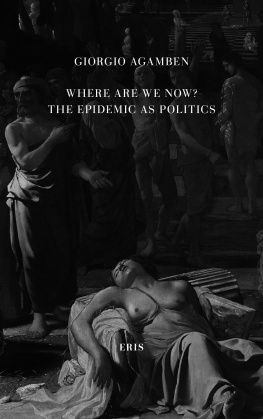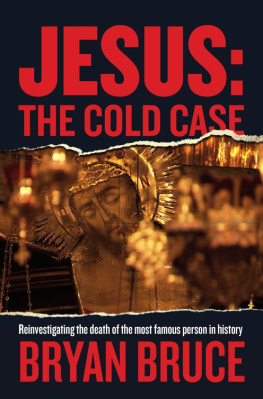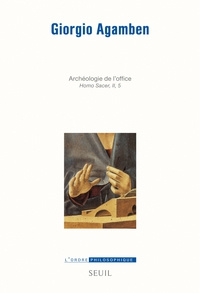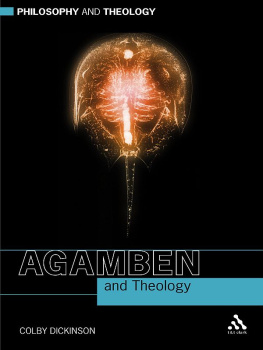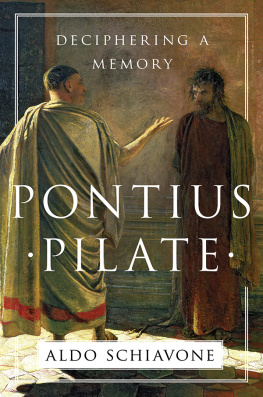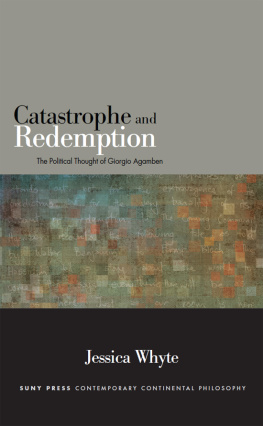MERIDIAN
Crossing Aesthetics
Werner Hamacher
Editor
PILATE AND JESUS
Giorgio Agamben
Translated by Adam Kotsko
STANFORD UNIVERSITY PRESS
STANFORD, CALIFORNIA
Stanford University Press
Stanford, California
English translation 2015 by the Board of Trustees of the Leland Stanford Junior University. All rights reserved.
Pilate and Jesus was originally published in Italian in 2013 under the title Pilato e Ges 2013, Nottetempo.
No part of this book may be reproduced or transmitted in any form or by any means, electronic or mechanical, including photocopying and recording, or in any information storage or retrieval system without the prior written permission of Stanford University Press.
Printed in the United States of America on acid-free, archival-quality paper
Library of Congress Cataloging-in-Publication Data
Agamben, Giorgio, 1942 author.
[Pilato e Ges. English]
Pilate and Jesus / Giorgio Agamben ; translated by Adam Kotsko.
pages cm. (Meridian, crossing aesthetics)
Originally published in Italian in 2013 under the title Pilato e Ges.
Includes bibliographical references.
ISBN 978-0-8047-9233-2 (cloth : alk. paper)
ISBN 978-0-8047-9454-1 (pbk. : alk. paper)
. Pilate, Pontius, active 1st century. 2. Jesus ChristTrial. 3. Jesus ChristCrucifixion. I. Title. II. Series: Meridian (Stanford, Calif.)
BS2520.P55A7313 2015
232.96'2dc23
2014030860
ISBN 978-0-8047-9458-9 (electronic)
Contents
Acknowledgments
The translator would like to thank Carlo Salzani and Harold Stone for their helpful comments on the translation; Colleen McCarroll for her bibliographical assistance; and Emily-Jane Cohen, Friederike Sundaram, and the entire staff at Stanford University Press.
The symbolon, the creed in which Christians summarize their faith, contains, alongside those of the Lord Jesus Christ and the Virgin Mary, a single proper name, completely extraneousat least in appearanceto its theological context. What is more, this man is a pagan, Pontius Pilate: staurothenta te huper hmon epi Pontiou Pilatou, crucified for our sake under Pontius Pilate. The creed that the Fathers had formulated at Nicea in 325 did not include this name. It was added in 381 by the Council of Constantinople, by all evidence in order to also fix the historical character of Jesuss passion chronologically. The Christian Credo, it has been observed, speaks of historical events. Pontius Pilate belongs there essentially. He is not just a pitiful creature who oddly ended up there (Schmitt, 930/170).
That Christianity is a historical religion, that the mysteries of which it speaks are also and above all historical facts, is taken for granted. If it is true that the incarnation of Christ is a historical event of infinite, non-appropriable, non-occupiable singularity (ibid.), the trial of Jesus is therefore one of the key moments of human history, in which eternity has crossed into history at a decisive point. All the more urgent, then, is the task of understanding how and why this crossing between the temporal and the eternal and between the divine and the human assumed precisely the form of a krisis, that is, of a juridical trial.
Why precisely Pilate? A formula of the type Tiberiou kaesaroswhich one reads on the money coined by Pilate and which has in its favor the authority of Luke, who so dates Johns preaching (Luke 3:1)or sub Tiberio (as Dante has Virgil say: born sub Iulio, Inferno 1.70) would certainly have been more in keeping with common usage. If the Fathers assembled at Constantinople preferred Pilate to Tiberius, the prefector, as Tacitus preferred to call him (Annals XV, 44), in one of the few extrabiblical testimonies that mention his name, the procurator of Judeato Caesar, it is possible that over their undoubted chronographic intention there prevailed the importance that the figure of Pilate has in the narrative of the Gospels. In the punctilious attention with which John above all, but also Mark, Luke, and Matthew describe his hesitations, his evasions and changing opinion, literally relating his words, which are at times decidedly enigmatic, the evangelists reveal perhaps for the first time something like the intention to construct a character, with his own psychology and idiosyncrasies. It is the vividness of this portrait that caused Lavater to exclaim in a 1781 letter to Goethe: I find everything in him: heaven, earth, and hell, virtue, vice, wisdom, folly, destiny, liberty: he is the symbol of all in all. One can say, in this sense, that Pilate is perhaps the only true character of the Gospels (Nietzsche defined him in The Antichrist as the only figureFigurof the New Testament who merits respect, 46), a man of whom we know the passions (he was greatly amazed, Matthew 27:14; Mark 15:5; he was more afraid than ever, John 19:8), the resentment and skittishness (as when he shouts at Jesus, who is not responding to him: Do you refuse to speak to me [emoi ou laleis]? Do you not know that I have power to release you, and power to crucify you?), the irony (at least according to some, in the notorious reply to Jesus: What is truth? John 18:38), the hypocritical scruples (testimony of which is found in the raising of a question of competency with Herod as much as in the ritual washing of his hands, with which he believes he can purify himself of the blood of the just man he has condemned), and the anger (the peremptory what I have written, I have written to the priests who ask him to change the inscription on the cross, John 19:22). We even make a fleeting acquaintance with his wife, who during the trial sends word to him not to condemn Jesus, for today I have suffered a great deal because of a dream about him (Matthew 27:19).
Mikhail Bulgakov, in the marvelous stories about Pilate that the devil recounts in The Master and Margarita, and Alexander Lernet-Holenia, in the grandiose theological farce inserted in The Count of Saint-Germain, both recall this vocation to become a character. But early on there is testimony, in the texts that we persist in calling New Testament apocrypha (the term, which has come to mean false, nonauthentic, in truth simply means hidden), to the presence of a true and proper Pilate cycle. This begins first of all in the Gospel of Nicodemus, in which the trial of Jesus is staged in a much more detailed way than in the synoptic gospels. When Jesus is introduced by Pilate, the banners that the standard bearers are holding in their hands miraculously bow down before him. In the trial twelve proselytes also intervene who testifyagainst the accusation that Jesus was a son of fornicationthat Joseph and Mary entered into a legal marriage, along with Nicodemus, who also testified in favor of Jesus. In general the whole trial is dramatically rendered here as a debate between the Jewish accusers, who are named one by one (Annas and Caiaphas, Semes, Dathaes and Gamaliel, Judas, Levi, and Nephthalim, Alexander and Jairus; Elliott, 170) and Pilate, who often appears to be beside himself and is almost openly on Jesuss side, also because his wife is pious and prefers to practice Judaism with the Jews (Elliott, 172). The dialogue with Jesus on truth, which in the canonical gospels ends abruptly with Pilates question, here, as we will see, continues and acquires a completely different significance. It is all the more unexpected when Pilate finally yields to the insistence of the Jews and, struck by a sudden fear, orders that Christ be flogged and crucified.
The legend of Pilate (the so-called Acta or Gesta Pilati) is constituted according to two divergent lines. First there is a white legend, attested by the pseudepigraphal letters to Tiberius and by the
Next page

